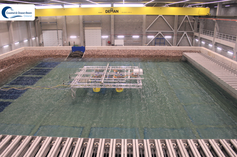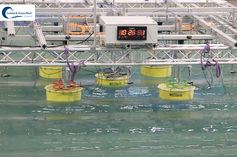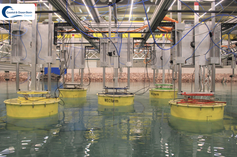Research
The coastal engineering research group is involved in several research projects, making use of the experimental facilities available and/or simulations obtained from in-house developed codes or commercial software.
The current areas of interest are the development of systems to exploit wave energy, coastal defense and more general wave-structure interactions and the development of numerical tools to simulate currents and waves in seas, estuaries and rivers.
The research in presented in various Articles in Peer-Reviewed Journals and Conference Publications.
Also have a look at fomer experience in research topics of the Coastal Engineering Research Group of Ghent University.
Wave energy conversion systems
Wave climate in the North Sea
Oceans are an enormous source of energy. The overall resource (approximately 2 TW) is of the same order of magnitude as the world’s electricity consumption. Till now the resource is studied in detail for regions with a high wave energy density. As Wave Energy Converters (WECs) still contend with problems regarding the survivability (structural strength and mooring) in a severe and energetic wave climate, the prospects of wave energy conversion in a less aggressive wave climate is now investigated. The Belgian Continental Shelf (BCS) is a rather sheltered area in the southern part of the North Sea. The wave climate is less aggressive as compared to open seas and therefore more likely to assure the survivability of WECs. A study of the wave climate on the BCS has been performed to identify the possibilities for wave energy conversion.
Array modeling of Wave Energy Convertors (WECs)
In order to extract a considerable amount of wave power, large numbers of Wave Energy Converters (WECs) will have to be arranged in arrays or farms using a particular geometrical layout. The operational behavior of a single device may have a positive or negative effect on the power absorption of the neighboring WECs in the farm (so-called near-field effects). As a result of the interaction between the WECs within a farm, the overall power absorption is affected. Finally, the wave height behind a large farm of WECs is modified, which may influence neighboring farms, other users in the sea or even the coastline (so-called far-field effects).
At Ghent University wake effects of single WECs but also large WEC farms have been studied physically during the 'WECwakes' project, within the framework of HYDRALAB and numerically using the in-house developed model MILDwave.
Since the completion of the WECwakes project, many numerical models have progressively advanced. To cover the scientific gap of experimental data necessary for the validation of recently developed (non-linear) numerical models, Ghent University and its partners have introduced the ’WECfarm’ project in 2018. In 2019 the ’WECfarm’ WEC has been designed and numerically modelled. In 2020 the first WEC has been constructed. In April 2021, this first WEC has been tested in the wave basin of Aalborg University (Denmark), being a project partner. The outcome of this test campaign allows a full evaluation of the WEC prior to the construction of the additional four WECs.
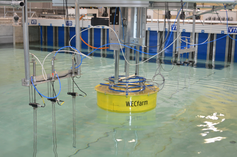
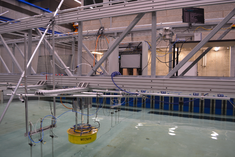
Experimental testing of the first WECfarm Wave Energy Converter at the wave basin of Aalborg University.
In February 2022, a two-WEC array has been tested in the wave basin of Aalborg University (Denmark). In 2023 experimental testing of arrays of up to five WECs is executed at the Coastal and Ocean Basin Ostend (Belgium).
Experimental testing of a five-WEC array at the Coastal & Ocean Basin Ostend.
This work was supported by the the FWO (Fonds Wetenschappelijk Onderzoek - Research Foundation Flanders), Belgium.
Optimization and hydrodynamic modelling of point absorbers
Experience from the FlanSea project:
Within the FlanSea (Flanders electricity from the Sea) project, a wave energy converter has been studied, designed, built and tested at the Belgian coast. This energy converter is a heaving point absorber, meaning a floating body from which energy is extracted from the up- and down movement. All aspects e.g. shape, power take off and survival conditions of the system will be studied in order to make the best design decisions. During the testing period forces, pressures and movement have been monitored to gain experience in the behavior of the system. The project was in cooperation with 6 industrial partners, that have expertise in different project aspects. Our research group has focused on hydrodynamic interaction and modeling.
Hydrodynamic modelling:
Within our the Coastal Engineering Research Group of UGent there is significant expertise and experience in numerical modelling of point absorber wave energy converters (WECs). The computational fluid dynamics solver OpenFOAM is applied to simulate a heaving point-absorber within a numerical wave flume. Moreover, the wave-structure interaction solver Nemoh (Ecole Centrale de Nantes) is used to model heaving WECs in the frequency domain. Both solvers can be coupled to a wave propagation solver (MILDwave or OceanWave3D) to model near field and far field effects for large WEC arrays.
Wave-structure interaction at coastlines and offshore structures
Experimental tests on breakwaters and sea dikes
The small and large wave flumes are used for experimental modeling of coastal structures, mainly breakwaters and sea dikes. Tests are carried out to investigate projects and to identify innovative solutions to a given problem. The main topics studied in the wave flume are:
- the forces on and overtopping discharges over reductive measures behind dikes and quay walls
- the stability of rubble mound breakwaters as well as armor units
- the stability of scour protection under combined wave and current loads.
Wave overtopping
Wave overtopping can affect people, buildings and infrastructures located behind a coastal defence structure, by even causing loss of lives and structural damage. The understanding of the overtopping process for different types of structures (sloping structures and vertical walls) is key to provide a correct design of coastal defence systems and to reduce its harmful effect on people and properties. We perform experimental model tests in our facilities to study and analyse the wave overtopping process under different wave and structural conditions.
The Coastal Engineering Research Group is co-authoring the new update of the EurOtop manual, which is a world-renowned manual describing methods to predict wave overtopping of sea defences and related coastal or shoreline structures. Several research results from our group will be included in this new version of the EurOtop manual.
Porous flow in breakwaters
When studying wave interaction with permeable coastal structures, the so-called ‘porous flow’ within the structure, induced by the wave action, plays a part in the hydraulic design of the structure, affecting e.g. wave run-up and overtopping, or the pressures acting upon the armor layer. The porous flow is studied both experimentally and numerically. Particular attention is paid to a proper geometric scaling of the stone grading in order to maintain flow similarity between physical models at different geometric scales.
Impact of waves on horizontal and vertical walls
In order to assess the loading conditions due to violent wave impacts, a vertical structure with an overhanging cantilever slab has been tested in a test set-up with a scale factor of 1:20 with the aim to bring a new design tool to assess violent water wave impacts based on the correlation between the kinematics of breaking waves. Waves are classified into 4 breaker types as: slightly breaking waves, breaking waves with small and large air trap and broken waves. The largest peak pressures are recorded for breaking waves with small air trap at the still water level and at the attached corner of the cantilever surface.
Overtopping flow and impact on storm walls or buildings
The typical Belgian coastal profile consists of a shallow foreshore, followed by a sloping dike structure and a promenade with a storm wall or building on top. This setting makes it possible for waves to run-up and overtop the dike structure. Within the Coastal Engineering Research Group, the processes resulting in overtopped flow formation, variation over the crest and final interaction of the overtopped flow with a storm wall or a building are studied. A better understanding of these processes will result in an improved design guidance for this type of structures. Storm walls are typically designed to limit a certain amount of water overtopping the structure, not taking into account the wave induced forces. Hence, our main research objective is to investigate the missing link between individual overtopping volumes and loads on the storm wall or building.
WaLoWa project
Within the European project ‘Wave Loads on Walls’ (WaLoWa) model tests in the Delta flume (The Netherlands) have been conducted. It is the aim to study overtopping wave impacts on storm walls and buildings.
Coastal safety
The CREST project
The fundamental strategic research project “CREST – Climate REsilient coaST: wave action in a changing climate; effects on the dynamics of the coast and implications for future safety strategies”, is funded by the Flemish Agency for Innovation by Science and Technology (VLAIO). The main objective of the CREST project is to gain a better understanding of the nearshore and onshore physical processes and flood risks and to determine the resilience of the coastal system, in order to deal in the most appropriate way with the possible impact of climate change.
The research at the Coastal Engineering Research Group of UGent, within the CREST project, focuses on developing and applying advanced numerical models, and on carrying out supporting physical model test and field measurements. This will establish a prediction methodology for wave overtopping, wave impact forces on sea defences, and risk for casualties in buildings on sea dikes, for the specific case of very shallow foreshores (typical Belgian case with beach nourishment and dike crest, but widely applicable). Numerical modelling using the open source Navier-Stokes solver OpenFOAM is being performed. Parallel to numerical modelling, experimental model tests and field measurements are performed to provide validation data. Both numerical and physical model results are used to characterize the hydrodynamic forcing and the structural stability of storm walls and buildings on top of the dike crest.
Wave transformation processes
A typical coastal profile along the Belgian coast consists of a shallow foreshore, followed by a sloping dike or dune structure and a promenade with a storm wall or a building on top. To predict the overtopping water volume, the related impact forces and to prevent flooding, reliable wave parameters at the toe of the dike in shallow water conditions are required. Hence, numerical models such as SWASH are applied to model the wave parameters at the dike toe. Moreover, hydraulic model experiments featuring different foreshore slopes are conducted in our facilities to obtain a better knowledge of wave parameters at the dike toe.
Investigation of structural measures to ensure coastal safety
In order to make the coast more resilient against rising sea levels, a number of structural countermeasures are investigated which can be divided into conventional hard and soft protection measures. The soft protection measures involve dune stabilization and beach nourishment schemes whereas the hard protection measures are focused on structural changes such as dikes, revetments, or storm walls. For the latter, hydraulic model tests are conducted in our facilities for different set-ups: vertical storm walls, storm walls with a parapet or a combination of storm walls forming a stilling wave basin. The analyzed data is used to provide guidance on wave overtopping volumes and impact forces for this type of structures.
Innovative scour protection
Offshore wind turbine foundations suffer from bottom erosion caused by the combined action of currents and waves, and therefore a scour protection is placed around the foundation to prevent the erosion. A more accurate prediction of the required stone size and gradation to achieve a stable scour protection is investigated using physical model tests in the laboratory wave flume.
Development of numerical modeling tools
MILDwave
The numerical model MILDwave is the in-house developed mild-slope wave propagation model based on the equations of Radder and Dingemans (1985). Typical application of the model is the study of wave penetration in harbours worldwide, and in Belgium for Zeebrugge and Ostend. The behavior of wave energy converters has also been studied using a pioneering ‘sponge layer’ technique. Several wave transformation studies at coastal areas worldwide have been carried out using MILDwave, including the areas along the Belgian coast, e.g. Thorntonbank, Flemish Bays etc.. MILDwave is also used in the coastal engineering research group at Ghent University for several research and educational purposes within the frame of PhD research and Master theses. Moreover, MILDwave is the official wave propagation model used by the Flemish government for calculating and modeling wave penetration into several Belgian coastal harbors, within the project of Integrated Flood Risk Management of the Belgian coast.
Algorithmic developments within COHERENS
Hydrodynamic and morphological challenges during the development of harbor extensions, alternative dredging strategies and sediment influx reducing measurements for the Flemish North Sea Ports are studied by the Maritime Access Division of the Flemish Government by using numerical tools. We assist in the development of the software needed to simulate currents and tidal propagation in seas, estuaries and rivers. The software developments are carried out within the framework of COHERENS, a 3-D hydrostatic free surface flow solver. The main contributions of the Coastal Engineering group consist in increasing the code's efficiency as much as possible. In this respect, the development of an implicit numerical scheme for the hydrodynamical equations has been an important achievement.
A numerical wave flume within Flow3D
A numerical wave flume has been developed using the CFD-code FLOW-3D®. This code solves the Navier-Stokes equations in 3D using finite-volume approximations and the volume-of-fluid (VoF) approach to track the free surface, allowing to study the wave interaction with coastal structures of different typology and in a large variety of conditions. Methods for generation and absorption of surface waves have been implemented. The numerical model has been validated with experimental measurements on coastal structures, e.g. on porous flow .
A numerical wave tank within OpenFOAM

The open source CFD package OpenFOAM is used within the Coastal Engineering Research Group of UGent to perform numerical simulations of offshore and coastal processes. This code solves the Navier-Stokes equations in 3D using finite-volume approximations and the Volume-of-Fluid (VoF) method to track the free water surface. Wave generation and absorption are implemented in a numerical wave tank using the IHFOAM toolbox. This available wave tank is intensively used to study the interaction between waves and floating point absorber wave energy converters. The CFD solver allows to include important non-linear wave-structure interactions, viscous forces and turbulent effects, which are absent in other simplified models.
The main contributions of the Coastal Engineering Research Group of UGent consist of developing a generic and efficient method to simulate multiple closely-spaced floating bodies in an incident wave field. High performance computers are employed to obtain accurate results within a reasonable calculation time. Moreover, the same numerical wave tank is developed within our group to study wave-current interaction, wave overtopping and wave impact forces on storm walls and buildings on top of the dike crest, e.g. within the CREST project.
More info
For more information on the research carried out at the Coastal Engineering Research Group of Ghent University please contact Prof. Peter Troch.
